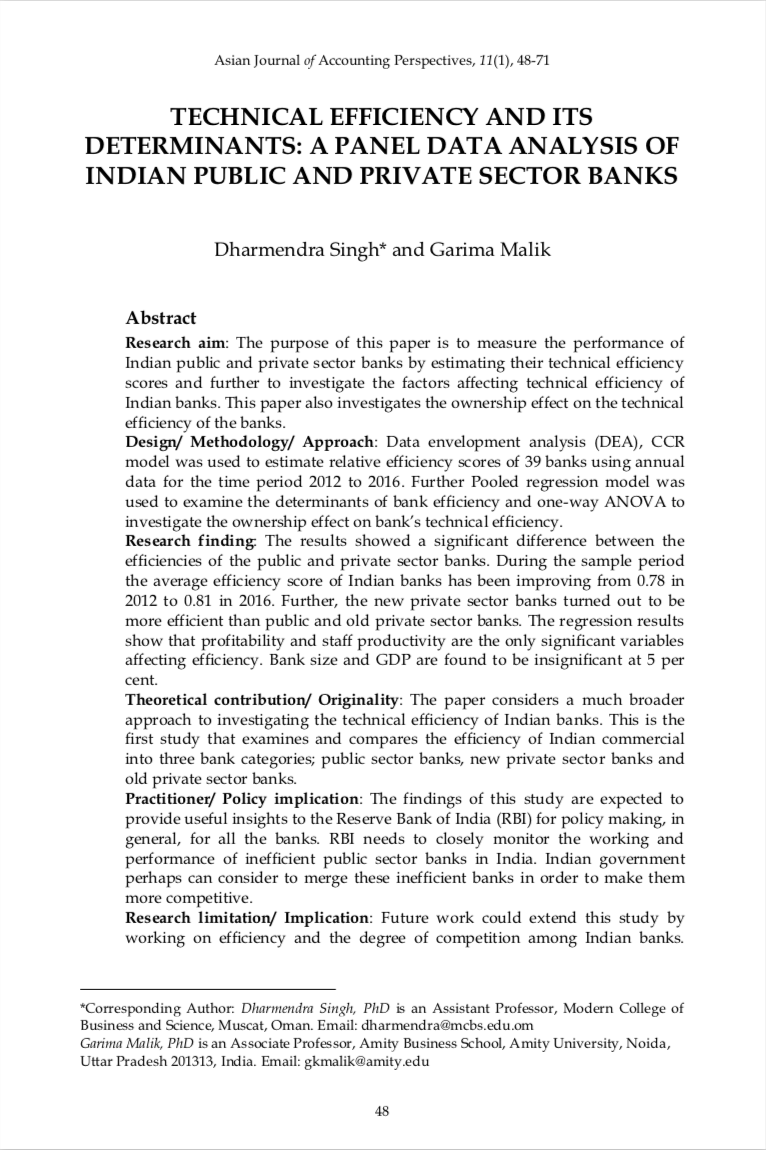Technical Efficiency and Its Determinants: A Panel Data Analysis of Indian Public and Private Sector Banks
Main Article Content
Abstract
Research aim: The purpose of this paper is to measure the performance of Indian public and private sector banks by estimating their technical efficiency scores and further to investigate the factors affecting technical efficiency of Indian banks. This paper also investigates the ownership effect on the technical efficiency of the banks.
Design/ Methodology/ Approach: Data envelopment analysis (DEA), CCR model was used to estimate relative efficiency scores of 39 banks using annual data for the time period 2012 to 2016. Further Pooled regression model was used to examine the determinants of bank efficiency and one-way ANOVA to investigate the ownership effect on bank’s technical efficiency.
Research finding: The results showed a significant difference between the efficiencies of the public and private sector banks. During the sample period the average efficiency score of Indian banks has been improving from 0.78 in 2012 to 0.81 in 2016. Further, the new private sector banks turned out to be more efficient than public and old private sector banks. The regression results show that profitability and staff productivity are the only significant variables affecting efficiency. Bank size and GDP are found to be insignificant at 5 per cent.
Theoretical contribution/ Originality: The paper considers a much broader approach to investigating the technical efficiency of Indian banks. This is the first study that examines and compares the efficiency of Indian commercial into three bank categories; public sector banks, new private sector banks and old private sector banks.
Practitioner/ Policy implication: The findings of this study are expected to provide useful insights to the Reserve Bank of India (RBI) for policy making, in general, for all the banks. RBI needs to closely monitor the working and performance of inefficient public sector banks in India. Indian government perhaps can consider to merge these inefficient banks in order to make them more competitive.
Research limitation/ Implication: Future work could extend this study by working on efficiency and the degree of competition among Indian banks. There is also a scope of doing research on impact of service quality dimensions on technical efficiency of banks in India.
Keywords: Commercial Banks, DEA, Indian Banking Sector, Regression, Technical Efficiency
Type of article: Research paper
JEL Classification: G21, C24
Downloads
Article Details
License
The Asian Journal of Accounting Perspectives (AJAP) articles are published under a licence equivalent to the Creative Commons Attribution-NonCommercial-NoDerivs License (CC BY-NC-ND). The licence allows users to copy, distribute, and transmit an article as long as the author is attributed. The article is not used for commercial purposes. The work is not modified or adapted in any way.
Copyright
Authors are required to sign the Exclusive License to Publish agreement upon publication in the AJAP. The agreement grants the Publisher (Faculty of Business and Accountancy, Universiti Malaya) to publish and disseminate the articles.
Open Access
Articles published in the AJAP are digital, online, free of charge, and free of most copyright and licensing restrictions.
Article Processing Charge
Articles publish in AJAP is free submission, production and publication charges. However, all accepted articles are required for language editing. The AJAP officially appointed and outsourced proofreader will conduct this process, and the authors will cover the cost. AJAP does not profit from this process and transaction.
References
Baidya, M. K., & Mitra, D. (2012). An analysis of the technical efficiency of Indian public sector banks through DEA approach. International Journal of Business Performance Management, 13(3-4), 341.
Batir, T. E., Volkman, D. A., & Gungor, B. (2017). Determinants of bank efficiency in Turkey: Participation banks versus conventional banks. Borsa Istanbul Review, 17(2), 86-96.
Benston, G. J. (1965). Branch banking and economies of scale. The Journal of Finance, 20(2), 312-331.
Berger, A. N., & Humphrey, D. B. (1997). Efficiency of financial institutions: International survey and directions for future research. European journal of operational research, 98(2), 175-212.
Bhattacharyya, A, Lovell, C, A, & Sahay, P. (1997). The Impact of Liberalization on the productive efficiency of Indian Banks. European Journal of Operational Research, 98(2), 332-345.
Bonin, J.P., Hasan, I. & Wachtel, P. (2005). Bank performance, efficiency and ownership in transition countries, Journal of Banking & Finance, 29(4), 31-53
Casu, B. & Girardone, C. (2002). A Comparative Study of the Cost Efficiency of Italian Bank Conglomerates, Managerial Finance, 28(9), 3-23.
Casu, B. & Girardone, C. (2010). Integration and efficiency convergence in EU banking markets. Omega, 38(2), 260-267
Casu, B. & Molyneux, P. (2003). A comparative study of efficiency in European banking. Applied Economics, 35, 1865-1876.
Chakrabarti, R. & Chawla, G. (2005). Banking efficiency in India since the reforms: an assessment’. Money and Finance, 9(2), 31-47
Charnes, A., Cooper, W. W., & Rhodes, E. (1978). Measuring the efficiency of decision making units. European Journal of Operational Research, 2(6), 429-444.
Chatterjee, B. & Sinha, R. P. (2006). Cost Efficiency and Commercial Bank Lending: Some Empirical Results. The Indian Economic Journal, 54(1), 145-165.
Das, A. (2000). Efficiency of Public sector banks: An application of data envelopment analysis model. Prajanan: Journal of Social and Management Sciences, 28(2), 119-131.
Das, A. (1997). Technical, Allocative and Scale Efficiency of Public Sector Banks in India. Reserve Bank of India Occasional Papers, Special Issue, 18(5), 279-301.
Das, A., & Ghosh, S. (2006). Financial deregulation and efficiency: An empirical analysis of Indian banks during the post reform period. Review of Financial Economics, 15(3), 193-221.
Farrell, M. J. (1957). The Measurement of Productive Efficiency. Journal of the Royal Statistical Society, Series A, 120(3), 253-290.
Fiordelisi, F., & Molyneux, P. (2010). The determinants of shareholder value in European banking. Journal of Banking and Finance, 34(4), 1189-1200.
Wozniewska, G. (2008). Methods of measuring the efficiency of commercial banks: an example of Polish banks. Ekonomika, 85, 81-91.
Gupta, O. K., Doshit, Y., & Chinubhai, A. (2008). Dynamics of productive efficiency of Indian banks. International Journal of Operations Research, 5(2), 78-90.
Hasan, I. & K. Marton. (2003). Development and efficiency of the banking sector in a transitional economy: Hungarian experience. Journal of Banking and Finance, 27, 2249-2271.
Isik, I. & Darrat, A.F. (2009). The effect of macroeconomic environment on productive performance in Turkish banking, Working Paper No. 487, Economic Research Forum, May
Isik, I & Hassan, M.K. (2002). Technical, Scale and Allocative Efficiencies of Turkish Banking Industry. Journal of Banking and Finance, 26(4), 719–766.
Jagwani, B. (2012). Efficiency measurement in the Indian banking industry: An application of data envelopment analysis. Vision, 16(4), 315-331.
Kumar S. & Gulati, R. (2008). An Examination of Technical, Pure Technical, and Scale Efficiencies in Indian Public Sector Banks using Data Envelopment Analysis. Eurasian Journal of Business and Economics, 1(2), 33-69.
Mancebon, M. & Bandres, E. (1999). Efficiency evaluation in secondary schools: the key role of model specification and ex post analysis of results, Education Economics, 7(2), 131-52.
Neal, P. (2004). X-efficiency and productivity change in Australian banking. Australian Economic Papers, 43, 174 – 191.
Rakesh Arrawatia & Arun Mishra. (2015). Assessment of completion of Indian Banking. European Journal of Business and Management, 4(20), 112-123.
Rangarajan, C., & Mampilly, P. (1972). Economies of scale in Indian banking, in: Technical Studies for Banking Commission Report, Reserve Bank of India, Mumbai, 244-268.
Ray, S. (2007). Are Some Indian Banks too Large? An Examination of Size Efficiency in Indian Banking. Journal of Productivity Analysis, 27(1), 41-56.
Reserve Bank of India (1977). Report of the Productivity, Efficiency and Profitability Committee on Banking, (Luther Committee).
Roy, D. (2014). Analysis of technical efficiency of Indian banking sector: An application of data envelopment analysis. International Journal of Finance and Banking Studies, 3(1), 150.
Saha. A, & T. S. Ravishankar. (2000). Rating of Indian Commercial banks: A DEA approach. European Journal of Operations Research, 124(12), 187-203
Sathye, M. (2001). X-Efficiency in Australian Banking: An Empirical Investigation. Journal of Banking and Finance, 25(3), 613-630.
Sathye, M. (2003). Efficiency of banks in a developing economy: the case of India. European Journal of Operational Research, 148(3), 662-671
Sealey, C. W., & Lindley, J. T. (1977). Inputs, outputs, and a theory of production and cost at depository financial institutions. The Journal of Finance, 32(4), 1251-1266.
Sharma, D., Sharma, A. K., & Barua, M. K. (2013). Efficiency and productivity of banking sector: A critical analysis of literature and design of conceptual model. Qualitative Research in Financial Markets, 5(2), 195-224.
Singh, D., & Fida, B. A. (2015). Technical efficiency and its determinants: An empirical study on banking sector of Oman. Problems and Perspectives in Management, 13(1), 168-175.
Singh, P. K., & Thaker, K. (2016). Dynamics of scale efficiency of Indian banks: A deterministic frontier approach. The Journal of Developing Areas, 50(3), 437-457.
Subrahmanyam, G. (1993). Productivity growth in India’s public sector banks: 1979- 89, Journal of Quantitative Economics, 9(3), 209-223.
Sufian, F. & Majid, M.A. (2007). Singapore Banking Efficiency and its Relation to Stock Returns: A DEA Window Analysis Approach. International Journal of Business Studies, 15(1), 83-106.
Tyagarajan, M. (1975). Expansion of commercial banking: An assessment. Economic and Political Weekly, 10, 1819-1824
Wozniewska, G. (2008). Methods of measuring the efficiency of commercial banks: an example of Polish banks. Ekonomika, 85, 81-91.
Yüksel, S., Mukhtarov, S., & Mammadov, E. (2016). Comparing the Efficiency of Turkish and Azerbaijani Banks: An Application with Data Envelopment Analysis. International Journal of Economics and Financial Issues, 6(3), 1059-1067.

